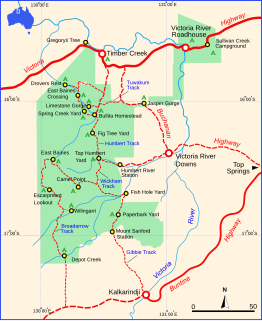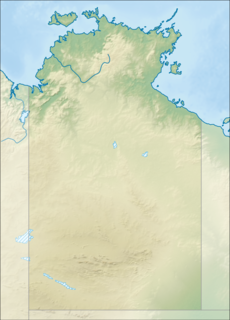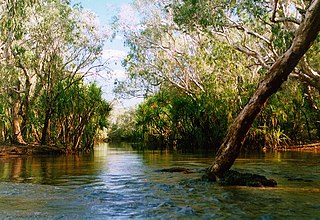| Wickham | |
|---|---|
Location of the Wickham River mouth in the Northern Territory | |
| Etymology | John Clements Wickham [1] |
| Location | |
| Country | Australia |
| Territory | Northern Territory |
| Region | Victoria Bonaparte (IBRA) |
| Physical characteristics | |
| Source | Mount Kimon |
| ⁃ elevation | 330 m (1,080 ft) |
| Mouth | Victoria River |
⁃ coordinates | 17°01′31″S129°57′52″E / 17.02528°S 129.96444°E Coordinates: 17°01′31″S129°57′52″E / 17.02528°S 129.96444°E |
⁃ elevation | 74 m (243 ft) |
| Length | 198 km (123 mi) |
| Basin size | 5,018 km2 (1,937 sq mi) |
| Discharge | |
| ⁃ average | 11.9 m3/s (420 cu ft/s) |
| Basin features | |
| Tributaries | |
| ⁃ left | Midnight Creek, Broadarrow Creek, Cusack Creek, Humbert River |
| ⁃ right | Soda Springs Creek, Depot Creek (Northern Territory), Gibbie Creek |
| National park | Judbarra / Gregory NP |
| [2] [3] | |
The Wickham River is an ephemeral river, located in the Victoria Bonaparte bioregion of the Northern Territory in Australia.

A river is a natural flowing watercourse, usually freshwater, flowing towards an ocean, sea, lake or another river. In some cases a river flows into the ground and becomes dry at the end of its course without reaching another body of water. Small rivers can be referred to using names such as stream, creek, brook, rivulet, and rill. There are no official definitions for the generic term river as applied to geographic features, although in some countries or communities a stream is defined by its size. Many names for small rivers are specific to geographic location; examples are "run" in some parts of the United States, "burn" in Scotland and northeast England, and "beck" in northern England. Sometimes a river is defined as being larger than a creek, but not always: the language is vague.

The Victoria Bonaparte, an interim Australian bioregion, is located in the Northern Territory and Western Australia, comprising 7,301,242 hectares.
A bioregion is an ecologically and geographically defined area that is smaller than an ecozone, but larger than an ecoregion or an ecosystem, in the World Wildlife Fund classification scheme. There is also an attempt to use the term in a rank-less generalist sense, similar to the terms "biogeographic area" or "biogeographic unit".




















